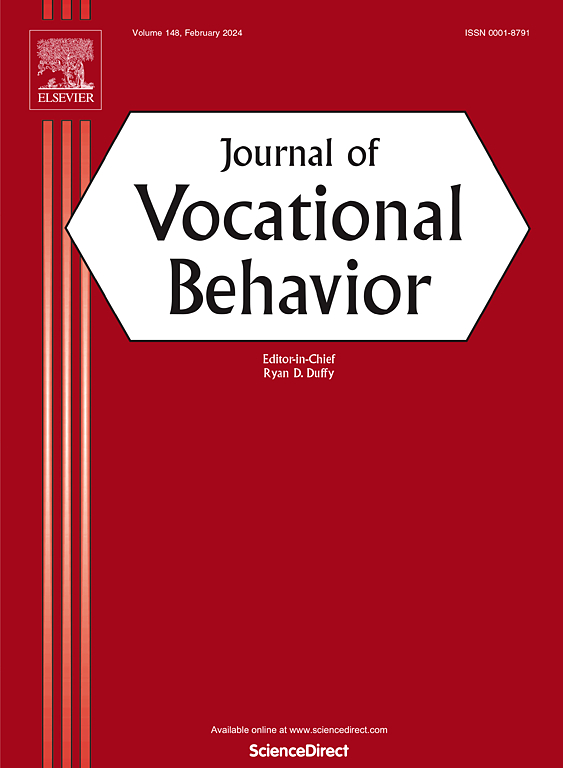Hybrid work design profiles: Antecedents and well-being outcomes
IF 5.2
1区 心理学
Q1 PSYCHOLOGY, APPLIED
引用次数: 0
Abstract
Hybrid work is fast emerging as the future of work. Yet, it is not clear how key work design characteristics that are salient in hybrid work, namely scheduling autonomy, social support, workload, and close monitoring, are experienced in the home compared to the workplace for hybrid workers, and how these work characteristics combine holistically to influence well-being. We adopted a novel approach and measured work characteristics as experienced at home and, separately, as experienced at the workplace. For a sample of hybrid workers (n = 386), latent profile analysis revealed four profiles of work design characteristics. Two profiles had similar work characteristics at home and the workplace. One of these profiles, labelled ‘active, low monitoring’, had very positive work characteristics across both locations, and was associated with the highest flourishing and mental health. The other profile, labelled ‘passive, high monitoring’, had very poor work design across both locations, and was associated with the lowest flourishing and mental health. The other two profiles diverged in work characteristic levels across locations. One profile, labelled ‘high strain, high monitoring’ had poor work design that was worse in the workplace, and one profile, labelled ‘low strain, low monitoring’, had better work design that was better at the workplace. Employees with more influence over their work location, and those with high organisational support, were likely to be in the most positive profile (active, low monitoring), suggesting these are important factors for creating positive work design irrespective of location.
混合工作设计概况:前因和幸福结果
混合工作正迅速成为未来的工作方式。然而,目前尚不清楚混合工作中突出的关键工作设计特征,即调度自主权、社会支持、工作量和密切监控,与混合工作人员在工作场所相比,在家中是如何体验的,以及这些工作特征如何整体地结合起来影响幸福感。我们采用了一种新颖的方法,测量了在家经历的工作特征,以及在工作场所经历的工作特征。对于混合型工作者样本(n = 386),潜在剖面分析揭示了工作设计特征的四种剖面。两份档案在家庭和工作场所有相似的工作特征。其中一种被标记为“积极,低监控”,在两个地方都有非常积极的工作特征,并且与最高的繁荣和心理健康有关。另一组被标记为“被动、高监控”,在两个地方都有非常糟糕的工作设计,并且与最低的繁荣和心理健康有关。另外两种情况在不同地点的工作特征水平上存在差异。一组被标记为“高压力,高监控”的人的工作设计很差,在工作场所更糟糕,而另一组被标记为“低压力,低监控”的人的工作设计更好,在工作场所也更好。对工作地点有更大影响力的员工,以及那些得到组织高度支持的员工,可能是最积极的(积极,低监控),这表明这些都是创造积极工作设计的重要因素,而与工作地点无关。
本文章由计算机程序翻译,如有差异,请以英文原文为准。
求助全文
约1分钟内获得全文
求助全文
来源期刊

Journal of Vocational Behavior
PSYCHOLOGY, APPLIED-
CiteScore
13.10
自引率
5.40%
发文量
85
期刊介绍:
The Journal of Vocational Behavior publishes original empirical and theoretical articles offering unique insights into the realms of career choice, career development, and work adjustment across the lifespan. These contributions are not only valuable for academic exploration but also find applications in counseling and career development programs across diverse sectors such as colleges, universities, business, industry, government, and the military.
The primary focus of the journal centers on individual decision-making regarding work and careers, prioritizing investigations into personal career choices rather than organizational or employer-level variables. Example topics encompass a broad range, from initial career choices (e.g., choice of major, initial work or organization selection, organizational attraction) to the development of a career, work transitions, work-family management, and attitudes within the workplace (such as work commitment, multiple role management, and turnover).
 求助内容:
求助内容: 应助结果提醒方式:
应助结果提醒方式:


